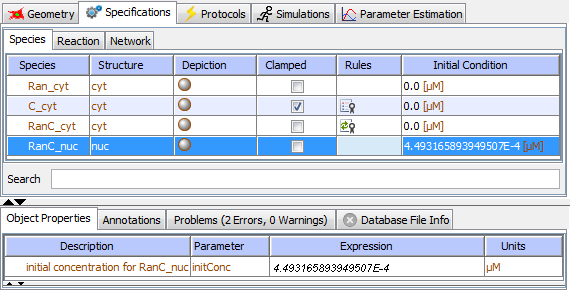Species Specifications
For any application, the species initial conditions need to be set.
In addition, other parameters like diffusion constant, boundary conditions and velocity
terms for species need to be specified for spatial applications.
This is done in the Specifications tab of an Application.
Non-Spatial Deterministic

Spatial Deterministic

Spatial Stochastic

Non-Spatial Stochastic

Columns values for a selected species row can be changed with the mouse pop-up menu. Initial condition expressions and values can be copied/pasted using the mouse pop-up menu.

Viewing/Editing Species Specifications
- Sort rows by values under a particular column by clicking the column 'header' (column names at the top of the table).
- Select a species from the table to display the 'Species Properties Pane' in the Properties panel below the table.
- Edit Initial Condition by selecting a 'Species' table row and entering an expression in one of 3 ways.
(1) double-click the 'Initial Condition' table-cell in the 'Species' table.
(2) pop-up menu over 'Species' table and select 'Initial Condition'.
(3) In the 'species properties' panel (below the 'Species' table) select the 'initConc' or 'initCount' parameter row and double-click the 'Expression' table-cell.
The expression can refer to other application parameters (press space for pop-up list).
In spatial applications an expression may be used to restrict the initial condition to a certain region within the application geometry domain by referring to axes (x, y or z) within the expression (e.g. (1000.0 * (y>= 0.89))).
Field Data can also be used to import 'image' based spatially distributed 'initial conditions'.
- Convert Concentration/Counts of 'Initial Conditions' for Stochastic applications
(see Application Overview) by selecting the Concentration or Number of Particles radio button.
- Edit Diffusion Expression (for spatial application) by selecting a 'Species' table row and entering an expression in one of 3 ways.
(1) double-click the 'Diffusion Constant' table-cell in the 'Species' table.
(2) pop-up menu over 'Species' table and select 'Diffusion Constant'.
(3) In the 'species properties' panel (below the 'Species' table) select the 'diff' parameter row and double-click the 'Expression' table-cell.
The diffusion expression can refer to other application parameters (press cntrl for pop-up list) and spatial axes x,y,z (e.g (10.0*(y>4.0)) where the value 10 is confined within the area defined by the y coordinates).
In addition, The diffusion expression can refer to time (e.g. ((t>2.5)*3)) where diffusion would be 3 after simulation time 2.5).
- Clamp Concentration by selecting a 'Species' table row and clicking the check-box under the 'Clamped' column.
The concentration of the selected species remains constant for all simulation times and does not diffuse.
The species in this case is no longer a variable but instead becomes a parameter and the diffusion constant is disabled.
Known concentrations may be held constant in a reaction in order to aid in determining unknown concentrations of other species elements.
- Set Boundary Conditions (for spatial applications) by selecting a 'Species' table row then selecting a 'Species Properties' table row for a 'Description' column
item that starts with 'Boundary Condition...'.
The type of 'Boundary Condition' is set in Structure Mapping.
The default 'Boundary Condition' for a given species at each boundary (X-,X+, Y-,Y+, Z-,Z+) is fixed at either zero, when using Flux type,
or the concentration set in the Initial Condition field, when using Value type.
Each 'Boundary Condition' can be assigned an expression of flux ('Flux type') or a clamped concentration different from that entered in the Initial Conditions field ('Value type').
- Set Velocities for Directed Transport (2D or 3D spatial applications) by selecting a 'Species' table row then selecting a 'Species Properties' table row for a 'Description' column
item that starts with 'Velocity...'.
The velocities provided by the user are used to calculate the velocities of the species at any location within the model.
Velocities can be provided as constant values or as a function of spatial coordinates, x,y,z as well as time.
- Set Randomized Initial Condition (non-spatial stochastic applications, see 'Non-Spatial Stochastic' figure above) by clicking the
'Randomize Initial Condition' check-box.
The solver will select an initial condition value from a Poisson distribution with the user defined initial condition as the mean of the Poisson distribution.
- Set Force Continuous (for stochastic applications) by selecting a 'Species' table row and clicking the
'Force Continuous' column (spatial stochastic) check-box. The checked species will be treated by the solver as determistic (continuous) variables.
Stochastic applications with 1 or more 'Force Continuous' check-boxes set are considered to be Hybrid Deterministic Stochastic.
- Rules (for non-spatial deterministic applications, view only) Indicates if
a rate rule or an assignment rule is associated to the species (variable).





